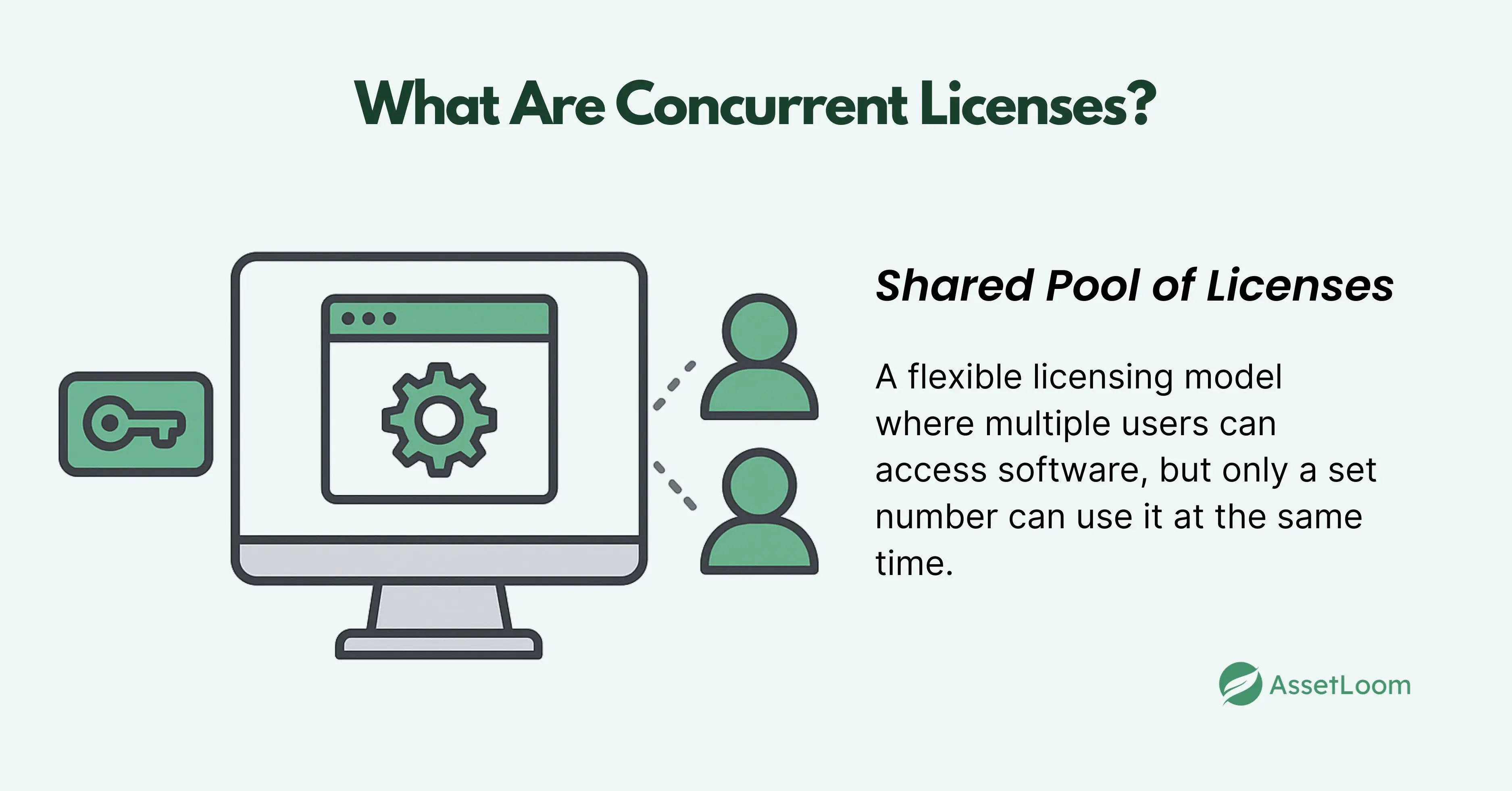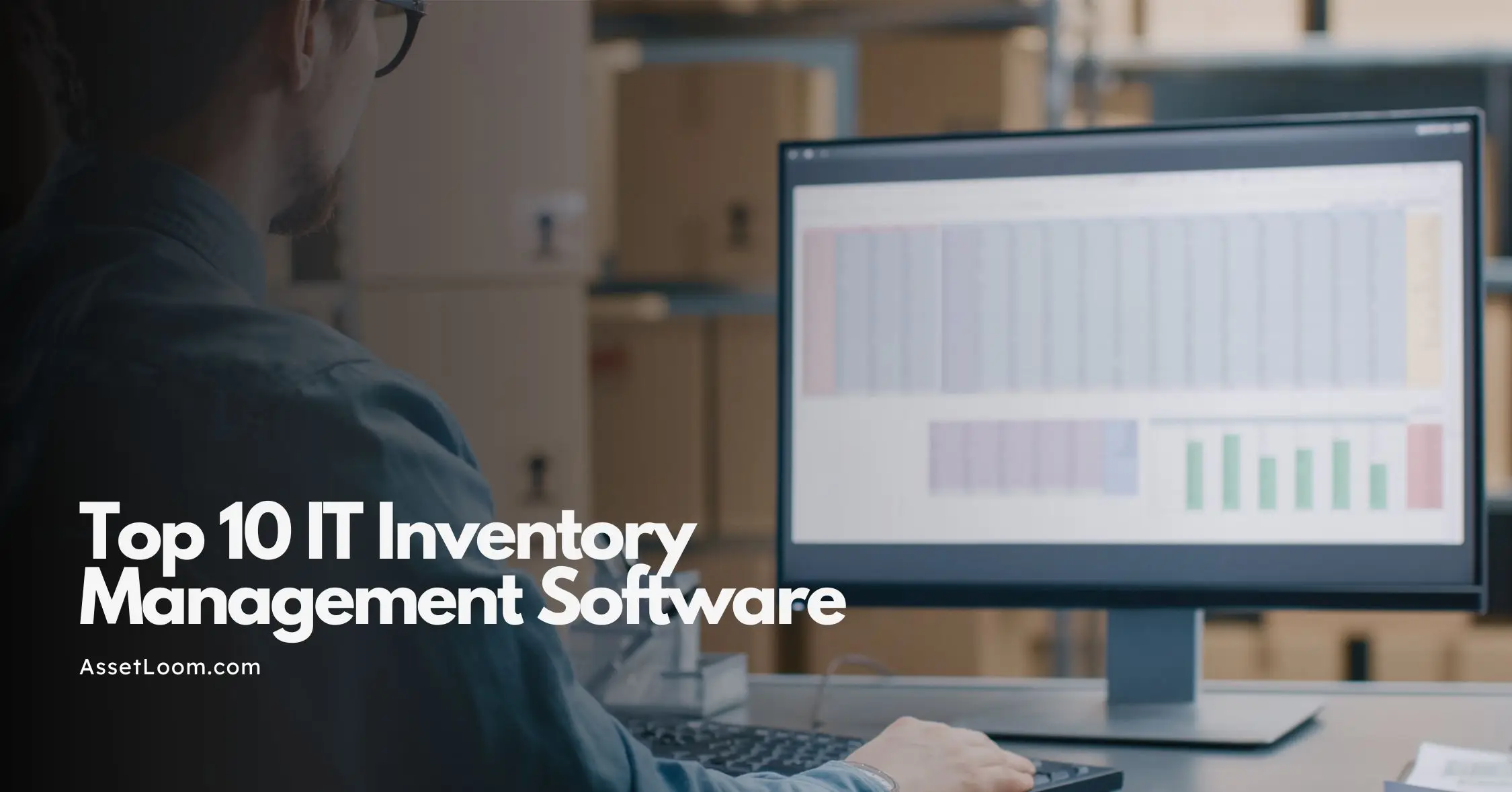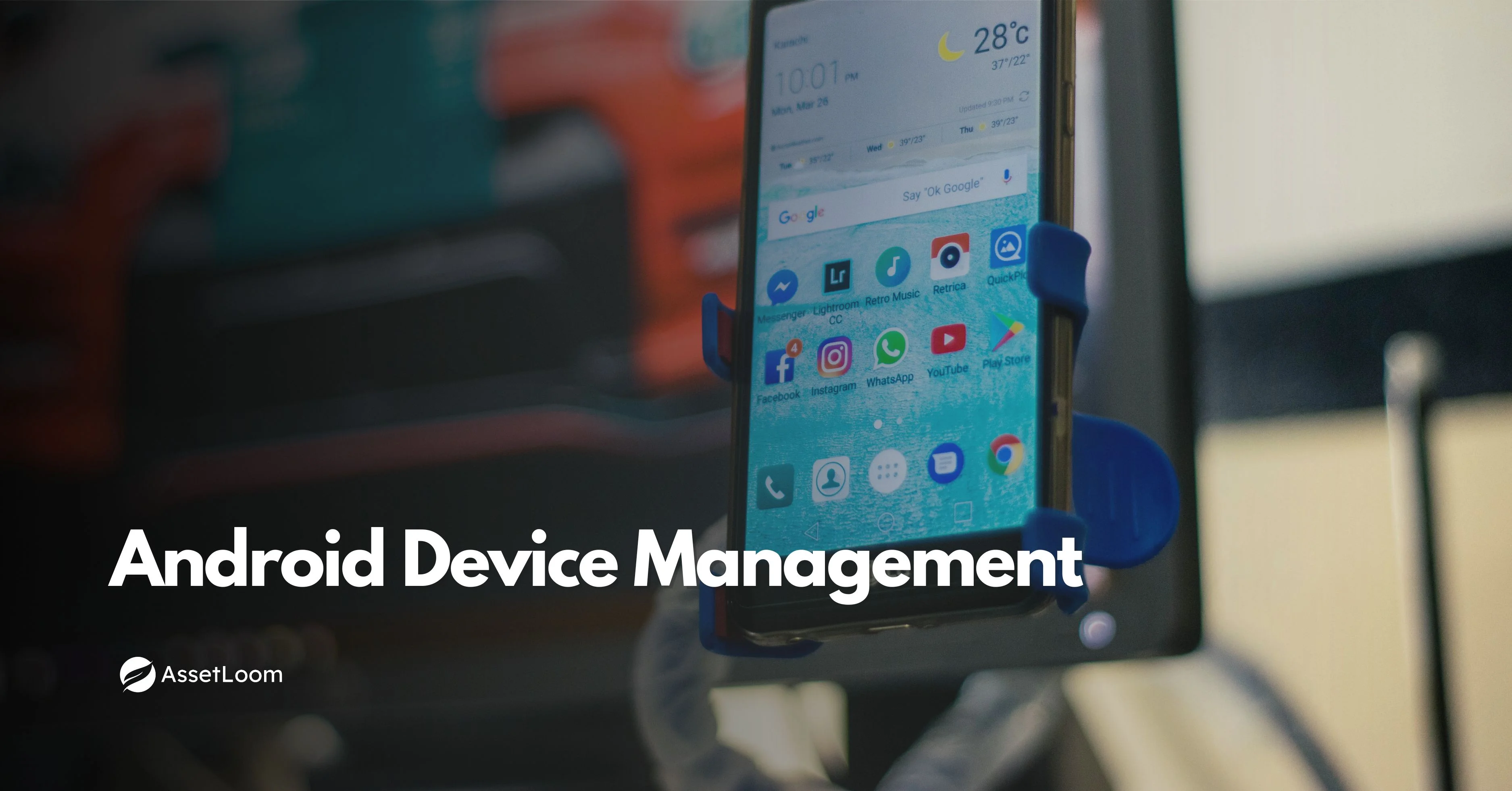Concurrent Licenses in ITAM: What IT Teams Need to Know
Concurrent Licenses allow multiple users to share access to software based on usage, making them a flexible and cost-effective option for IT teams managing software license allocation.
If you're in IT, you've faced this issue. You're paying for a bunch of software licenses, but it's unclear who’s using what or whether you’re using them efficiently.
Concurrent licenses allow a fixed number of users to access software at the same time, rather than assigning one license to each person. It’s more flexible in many cases, but it also introduces some complexity.
In this post, we’ll break down how concurrent licenses work, how they fit into your software license management approach, and what to keep in mind when using them as part of your IT asset management (ITAM) strategy.
What Are Concurrent Licenses?
A concurrent license is a type of software license that allows a limited number of users to access a software application at the same time. Instead of giving each person their license, you buy a pool of licenses that anyone can use, as long as the number of active users doesn’t go over the limit.
For example, if you have 10 concurrent licenses, up to 10 people can use the software at once. If an 11th person tries to log in, they’ll need to wait until someone else logs out.

This setup works well when not everyone needs the software all the time. It’s common in companies with shifts, part-time users, or teams who use the tool occasionally.
Concurrent licensing can help save money by avoiding unused licenses, but it also needs careful tracking to avoid access issues or license overuse.
How does a concurrent license work?
Concurrent licenses are managed based on the number of users actively using the software at the same time.
When someone opens the software, the system checks if a license is available. If yes, they get access and one license is marked as “in use.” When they close the program or log out, that license becomes available for someone else.
It doesn’t matter who the user is. What matters is how many people are using the software at once. If all licenses are in use, the next person trying to log in will be blocked or put in a queue until someone logs off.
To make this work smoothly, most systems that use concurrent licensing need a license server. This server keeps track of who’s using what and how many licenses are left.
Concurrent licenses work best when users come and go throughout the day rather than needing constant access.
Advantages and Disadvantages of Concurrent License
Concurrent licensing can be a smart way to manage software access, but it’s important to understand both the benefits and the trade-offs before you choose this software licensing model.
Advantages
- Flexibility: Users can access the software from different devices and locations, making it easier to support remote teams or shared workstations. You don’t have to reassign licenses every time someone joins or changes roles.
- Unlimited users, limited usage: You can create as many user accounts as you want. What matters is how many people are using the software at the same time.
- Cost efficiency: You only pay for the number of users who need the software at the same time. This works well when many people need occasional access but don’t all use it at once.
- Better resource use: Licenses don’t sit unused. They’re available to whoever needs them, whenever there’s an open spot.
Disadvantages
- Access limits: If more users try to log in than the number of available licenses, someone has to wait. This can slow down work if the number of licenses is too low.
- Hard to plan: You need to estimate how many users will need access at the same time. If you guess too low, people get blocked. If you guess too high, you overspend.
- Higher upfront cost: Concurrent licenses can cost more upfront compared to per-user licenses. The savings come over time if the model fits your usage.
- Requires tracking: You’ll need tools to monitor real-time usage. Without visibility, it’s hard to know if you're using the licenses effectively or risking non-compliance.
Concurrent Licenses in ITAM
Managing concurrent licenses is a key part of effective IT Asset Management (ITAM). Since these licenses are shared across users, IT teams need to keep track of how they’re being used, when they’re in use, and whether the number of licenses is still right for the organization.
Without proper tracking, it’s easy to lose visibility. You might run into situations where people can’t access critical tools because all licenses are in use, or you might be paying for more licenses than you need.
ITAM tools can help by providing reports on license usage, alerts when capacity is maxed out, and data to help decide whether to add or reduce license counts. Some systems also integrate directly with license servers to pull usage data automatically.
In short, concurrent licensing works best when it’s part of a structured ITAM process, not just something left on its own. When managed properly, it can be a cost-effective and flexible way to give teams access to the software they need.
Key Challenges for IT Teams
While concurrent licensing offers flexibility, managing it effectively isn't always easy. IT teams face several challenges that can cause delays, overspending, or compliance issues if not handled properly.
1. Tracking Real-Time Usage
One of the biggest challenges is knowing how many licenses are in use at any moment. If the system doesn't alert you when you're close to your limit, users may suddenly be blocked when they try to log in.
Example: A design team shares 10 concurrent licenses for a CAD tool. During a product launch, everyone logs in at once. The 11th person is denied access, delaying their work unless someone logs out.
2. Estimating the Right License Count
It's not always clear how many licenses you need. Usage might vary by time of day, team, or season. Guessing wrong leads to two common problems:
- Too few licenses mean users can’t get access when they need it.
- Too many licenses mean you're paying for capacity you don't use.
Example: An IT team buys 30 licenses for a system monitoring tool. After reviewing usage logs, they find the number of active users rarely goes above 15. That’s money they could’ve spent elsewhere.
3. Managing Peak Usage Times
Usage isn't always steady. There are often peaks during busy times like reporting periods, audits, or major releases. If you don’t plan for those peaks, you may end up scrambling to add temporary licenses or telling people to wait.
Example: A finance team uses analytics software heavily during end-of-quarter reporting. For most of the year, 5 licenses are enough, but in those few weeks, they need 15.
4. Limited Visibility Across Teams
In large or remote organizations, different teams may use the same software without coordination. IT may not know who’s using which tools or how often, making it hard to reassign or optimize license use.
Example: The marketing team and product team both use the same project management software, but there's no shared tracking. Both groups think they need more licenses, but it turns out there's an overlap that goes unnoticed.
5. Compliance and Audit Risks
If you’re ever audited, you need to show that your usage stayed within the licensed limits. Without clear logs, audit trails, or a reliable license management tool, proving compliance becomes difficult and risky.
Example: During a vendor audit, an organization is asked to provide usage data for the last 12 months. They don’t have detailed logs, so they can’t prove they stayed within the limits, even if they did. That can lead to fines or forced renewals.
When do I consider concurrent licensing?
Concurrent licensing is a good fit when not everyone needs to use the same software at the same time. If your team uses certain tools occasionally or in short bursts throughout the day, you might be paying for more licenses than you actually need. In these cases, having a shared pool of licenses that anyone can use, as long as the total number of active users stays within your limit, can save both time and money.
This model also works well in companies where people work in shifts or across different time zones. Instead of assigning one license to each user, teams can access the software as needed without having to constantly reassign access.
You might also consider concurrent licensing when software is tied to specific tasks or workflows, like reporting, analysis, or editing. If access tends to rotate between teams or only happens during certain periods, it doesn’t make sense to purchase a license for every single person. A shared approach gives you more flexibility.
On the other hand, if most of your users need full-time access to the software, a per-user license may be simpler and more predictable. But when your usage is spread out and you want to manage costs more efficiently, concurrent licensing is worth considering.
How to set up and use concurrent licenses
Setting up and using concurrent licenses takes a bit of planning, but once done right, it can make license management much easier. Here are the key steps:
1. Understand usage patterns
Before you buy or assign concurrent licenses, it’s important to get a clear picture of how your team uses the software. This helps avoid both overspending and access issues.
Start by asking a few questions:
- How often is the software used?
- Do people use it all day or just for short tasks?
- Are there specific times when usage spikes (like end-of-month reporting)?
- Are users spread across time zones or working in shifts?
You can gather this data by checking current usage logs, surveying users, or using monitoring tools. Look for trends in login times and duration. If usage is spread out during the day or varies by team, concurrent licensing can be a good fit.
For example, if you have 30 people who need access, but only 10 are using the software at any given time, you likely only need 10 concurrent licenses. Tracking this upfront helps you avoid paying for licenses that aren’t used, while still making sure your team has the access they need when they need it.
2. Install and configure a license server
To use concurrent licenses, most software vendors require a license server. This server keeps track of how many licenses are in use and who’s using them.
Here’s how it works:
- When a user opens the software, the server checks if a license is available.
- If yes, the user gets access, and one license is marked as in use.
- When the user logs out or closes the app, that license is freed up for someone else.
But what if someone opens the software and then walks away, or forgets to close it? In those cases, the license stays active, even if they’re not using it. That’s a common issue with concurrent licensing; unused licenses can get “stuck.”
To handle this, many license servers let you set idle timeouts. This means if a user is inactive for a certain period (like 30 or 60 minutes), the system automatically releases their license so someone else can use it. This helps prevent waste and ensures licenses aren’t locked up unnecessarily.
If your team doesn’t use the software often, you might find that your license count is higher than needed. Keep an eye on usage reports so you can reduce or reallocate licenses as needed. It’s better to adjust over time than to keep paying for access no one is using.
3. Set access rules and groups
Once your license server is running, the next step is to set clear rules for how licenses are shared across your team. This helps avoid conflicts and makes sure critical users aren’t blocked when all licenses are in use.
Depending on the software and license server, you may be able to:
- Prioritize certain users or teams so they always get access first
- Limit how many licenses a group can use to prevent one team from using up the entire pool
- Reserve licenses for specific roles, departments, or time zones
- Set time limits to release licenses after periods of inactivity
For example, you might want to make sure your finance team has guaranteed access to a reporting tool at the end of each month, while giving the rest of the company access on a first-come, first-served basis.
If your license server doesn’t support this level of control, you can still manage access by setting internal policies or using your ITAM tool to monitor and adjust usage manually.
Clear access rules reduce frustration and help everyone understand how shared licenses are meant to work. It also helps IT troubleshoot issues faster when someone gets locked out.
4. Monitor license usage
Once everything is set up, keeping an eye on how licenses are used is just as important as setting them up. Without monitoring, it's easy to miss signs that you're either running short on licenses or paying for more than you need.
Here’s what to focus on:
- Track real-time usage to see how many licenses are in use at any given time
- Look for patterns in usage over days, weeks, or months
- Identify peak times when users are more likely to get blocked
- Watch for idle or unused licenses that stay active even when no one is actually using them
Many license servers come with built-in reporting tools. You can also integrate license data into your IT asset management platform to get a broader view of how software is being used across the organization.
For example, if you notice that usage never goes above 5 licenses, but you’re paying for 15, that’s a clear sign it’s time to scale back. Or, if users are getting locked out regularly during certain hours, it may be worth increasing the license count or adjusting priorities.
Ongoing monitoring helps you stay compliant, cut unnecessary costs, and make sure the right people always have access when they need it.
5. Communicate with your team
Make sure users understand how concurrent licensing works. Let them know what happens if all licenses are in use, and what to do if they can’t access the software right away.
Conclusion
Concurrent licenses can be a useful way to manage software access, especially when not everyone needs to use the same tool at the same time. They offer more flexibility and can help save money by sharing licenses across users.
But to make this work well, you need a clear setup. That includes understanding how your team uses the software, setting up a license server, keeping an eye on usage, and helping your team know what to expect.
When done right, concurrent licensing can be a simple and effective part of your software license management and IT asset management process. It helps reduce waste, prevent access issues, and give your team what they need without overspending.

Related Blogs
Subscribe for Expert Tips and Updates
Receive the latest news from AssetLoom, right in your inbox.


